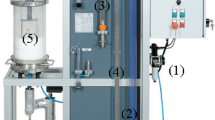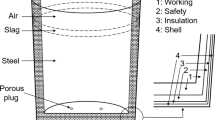Abstract
Nowadays, the liquid nitrogen cooling in aluminium extrusion is a widely adopted industrial practice to increase the process productivity as well as to improve the extruded profile surface quality by reducing the profile exit temperatures. The cooling channels are commonly designed on the basis of die maker experience only, usually obtaining modest performances in terms of cooling efficiency. Trial-and-error approach is time and cost consuming, thus providing a relevant industrial interest in the development of reliable numerical simulations able to foresee and optimize the nitrogen cooling effect during the die design stage. In this work, an extensive experimental campaign was performed during the extrusion process of an AA6060 industrial hollow profile, in different conditions of nitrogen flow rate and ram speed. The monitored data (die and profile temperatures and extrusion load) were compared with the outputs of a fast and efficient numerical model proposed by the authors, and developed in the COMSOL Multiphysics code, able to compute not only the effect of nitrogen liquid flow but also the gaseous condition. The results of the simulations showed a good agreement with experimental data, and evidenced how far the experimental cooling channel design from an optimized condition was.















Similar content being viewed by others
Availability of data and materials
Not applicable.
Code availability
Commercial code COMSOL Multiphysics (software application).
References
Saha PK (2000) Aluminum extrusion technology. ASM Int Materials Par, Ohio
Sheppard T (1999) Extrusion on Aluminum Alloys. Kluwer Academic Publisher, Boston
Staley JT, Liu J, Hunt WH (1997) Aluminum alloys for aerostructures. Adv Mater Process 152(4):17–20
Saha PK (1998) Thermodynamics and tribology in aluminum extrusion. Wear 218(2):179–190
Parson NC (1996) Surface Defects on 6xxx Alloy Extrusions, vol. 1. In: Proceedings of the 6th International Extrusion Technology Seminar, pp 57–67
Qamar SZ, Arif AFM, Sheikh AK (2004) Analysis of product defects in a typical aluminum extrusion facility. Mater Manuf Process 19(3):391–405. https://doi.org/10.1081/AMP-120038650
Qamar SZ, Pervez T, Chekotu JC (2018) Die defects and die corrections in metal extrusion. Metals 8(6):380. https://doi.org/10.3390/met8060380
Akhtar SS, Arif AFM (2010) Fatigue failure of extrusion dies: effect of process parameters and design features on die life. J Fail Anal Prev 10:38–49. https://doi.org/10.1007/s11668-009-9304-4
Stratton P (2008) Raising productivity of aluminium extrusion with nitrogen. Int Heat Treat Surf Eng 2(3–4):105–108. https://doi.org/10.1179/174951508X429221
Ward TJ, Kelly RM, Jones GL, Heffron J (1984) Effects of nitrogen - liquid and gaseous - on aluminum extrusion. J Miner Met Mater Soc 36(12):29–33
Brodbeck H (1984) Experience Using Liquid Nitrogen for Die Cooling. In: Proceedings of the Third International Aluminum Extrusion Technology Seminar (ET 1984), vol. 1. Atlanta, Georgia, the Aluminum Extruders Council and the Aluminum Association, pp 279–282
Marchese MA, Coston JJ (1988) Efficient Use of Liquid Nitrogen for Aluminum Extrusion Die Cooling and Inerting. In: Proceedings of Fourth International Aluminum Extrusion Technology Seminar (ET 1988), vol. 2. Chicago, Illinois, the Aluminum Extruders Council and the Aluminum Association, pp 83–88
Mainetti E, Bertoletti M, Wallfish S, Ferrentino A (2012) Significant Extrusion Speed Increase using Liquid Nitrogen to Eliminate Overheating of Dies During Extrusion Process. In: Proceedings of the Tenth International Aluminum Extrusion Technology Seminar (ET 2012), vol. 1. Miami, Florida, Extrusion Technology for Aluminum Profiles Foundation, pp 201–206
Donati L, Segatori A, Reggiani B, Tomesani L, Bevilacqua Fazzini PA (2012) Effect of liquid nitrogen die cooling on extrusion process conditions. Key Eng Mater 491:215–222. https://doi.org/10.4028/www.scientific.net/KEM.491.215
Reggiani B, Todaro I (2019) Investigation on the design of a novel selective laser melted insert for extrusion dies with conformal cooling channels. Int J Adv Manuf Technol 104(1–4):815–830. https://doi.org/10.1007/s00170-019-03879-9
Ronald J, Selines F, Lauricella C (1984) Extrusion Cooling and Inerting Using Liquid Nitrogen. In: Proceedings of the Third International Aluminum Extrusion Technology Seminar (ET 1984), vol. 1. Atlanta, Georgia, the Aluminum Extruders Council and the Aluminum Association, pp 221–226
Ciuffini AF et al (2018) Surface quality improvement of AA6060 aluminum extruded components through liquid nitrogen mold cooling. Metals 8(6):409. https://doi.org/10.3390/met8060409
Lemmon EW, McLinden MO, Friend DG (2018) Thermophysical Properties of Fluid Systems. In: Linstrom PJ, Mallard WG (eds) NIST Chemistry WebBook NIST Standard Reference Database Number 69. National Institute of Standards and Technology, Gaithersburg
Norwood AJ et al (2004) Analysis of cooling channels performance. Int J Comput Integr Manuf 17(8):669–678. https://doi.org/10.1080/0951192042000237528
Lurie MV (2008) Modeling of Oil Product and Gas Pipeline Transportation. Wiley-VCH Verlag GmbH & Co KGaA, Weinheim
Gnielinski V (1976) New equation for heat and mass transfer in turbulent pipe and channel flow. Int Chem Eng 16:359–368
Bastani AF, Aukrust T, Brandal S (2011) Optimisation of flow balance and isothermal extrusion of aluminium using finite-element simulations. J Mater Process Technol 211(4):650–667. https://doi.org/10.1016/j.jmatprotec.2010.11.021
Zhang C, Zhao G, Chen H, Guan Y, Kou F (2012) Numerical simulation and metal flow analysis of hot extrusion process for a complex hollow aluminum profile. Int J Adv Manuf Technol 60:101–110. https://doi.org/10.1007/s00170-011-3609-7
Reggiani B, Donati L (2019) Prediction of liquid nitrogen die cooling effect on the extrusion process parameters by means of FE simulations and experimental validation. J Manuf Process 41:231–241. https://doi.org/10.1016/j.jmapro.2019.04.002
Jiang Y, Wu R, Yuan C, Wang W, Jiao W (2019) Prediction and analysis of breakthrough extruding force based on a modified FE-model in large-scale extrusion process. Int J Adv Manuf Technol 104:3531–3544. https://doi.org/10.1007/s00170-019-04039-9
Liu Z, Li L, Yi J, Wang G (2019) Entrance shape design of spread extrusion die for large-scale aluminum panel. Int J Adv Manuf Technol 101:1725–1740. https://doi.org/10.1007/s00170-018-2991-9
Reggiani B, Segatori A, Donati L, Tomesani L (2013) Prediction of charge welds in hollow profiles extrusion by FEM simulations and experimental validation. Int J Adv Manuf Technol 69(5–8):1855–1872. https://doi.org/10.1007/s00170-013-5143-2
Lou S et al (2017) Analysis and prediction of the billet butt and transverse weld in the continuous extrusion process of a hollow aluminum profile. J Mater Eng Perform 26(8):4121–4130. https://doi.org/10.1007/s11665-017-2771-y
Reggiani B, Donati L, Tomesani L (2017) Multi-goal optimization of industrial extrusion dies by means of meta-models. Int J Adv Manuf Technol 88(9–12):3281–3293. https://doi.org/10.1007/s00170-016-9009-2
Lou S, Wang Y, Lu S, Su C (2018) Die structure optimization for hollow aluminum profile. Procedia Manuf 15:249–256. https://doi.org/10.1016/j.promfg.2018.07.216
Kim YT, Ikeda K (2000) Flow behavior of the billet surface layer in porthole die extrusion of aluminum. Metall Mater Trans A 31:1635–1643. https://doi.org/10.1007/s11661-000-0173-4
Qamar SZ (2004) Modeling and Analysis of Extrusion Pressure and Die Life for Complex Aluminum Profiles. King Fahd University of Petroleum & Minerals, Dhahran (Ph.D. Thesis)
Sellars CM, McGTegart WJ (1972) Hot workability Int Metall Rev 17(1):1–24
Nourani M, Milani AS, Yannacopoulos S (2014) On the effect of different material constitutive equations in modeling friction stir welding: a review and comparative study on aluminum 6061. Int J Adv Eng Technol 7(1):1–20
Verlinden B, Suhadi A, Delaey L (1993) A generalized constitutive equation for an AA6060 aluminum alloy. Scr Metall Mater 28:1441–1446. https://doi.org/10.1016/0956-716X(93)90496-F
Schikorra M, Donati L, Tomesani L, Tekkaya AE (2007) The Extrusion Benchmark 2007. In: Proceedings of the Extrusion Workshop 2007 and 2nd Extrusion Benchmark Conference, Bologna
COMSOL® Multiphysics (Version 5.4). Modelling software. https://www.comsol.it
Author information
Authors and Affiliations
Contributions
All authors contributed to the study conception and design. Material preparation, data collection and analysis were performed by Riccardo Pelaccia, Barbara Reggiani, Marco Negozio and Lorenzo Donati. The first draft of the manuscript was written by Riccardo Pelaccia and all authors commented on previous versions of the manuscript. All authors read and approved the final manuscript.
Corresponding author
Ethics declarations
Ethics approval and consent to participate
Not applicable. Informed consent was obtained from all individual participants included in the study.
Consent for publication
The participant has consented to the submission of the case report to the journal.
Competing interests
The authors declare no competing interests.
Additional information
Publisher's Note
Springer Nature remains neutral with regard to jurisdictional claims in published maps and institutional affiliations.
Rights and permissions
About this article
Cite this article
Pelaccia, R., Reggiani, B., Negozio, M. et al. Liquid nitrogen in the industrial practice of hot aluminium extrusion: experimental and numerical investigation. Int J Adv Manuf Technol 119, 3141–3155 (2022). https://doi.org/10.1007/s00170-021-08422-3
Received:
Accepted:
Published:
Issue Date:
DOI: https://doi.org/10.1007/s00170-021-08422-3




